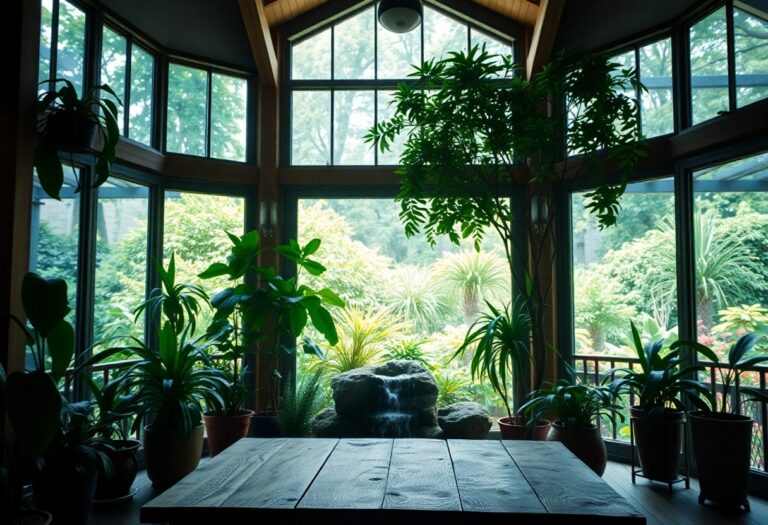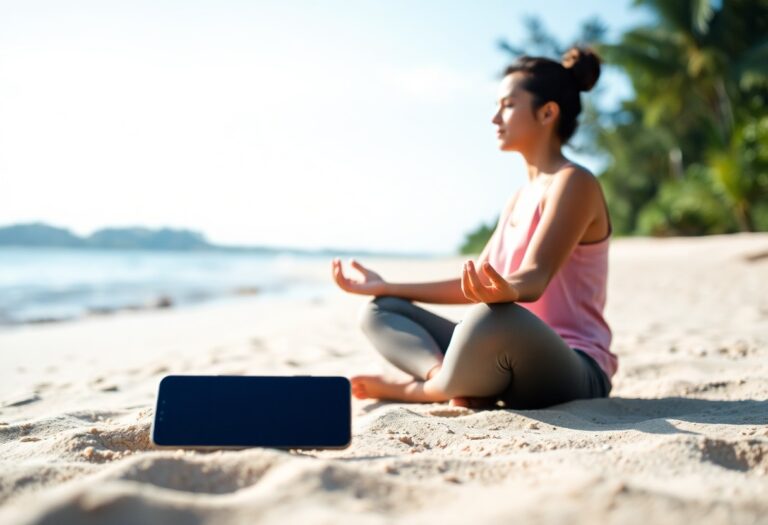With the fast-paced demands of daily life, it’s vital for you to create a space where you can unwind and recharge. Transforming your home into a sanctuary of peace and relaxation starts by incorporating elements that soothe your senses and promote a positive atmosphere. Consider decluttering your environment, choosing calming colors, and including natural elements like plants to enhance tranquility. By focusing on these important aspects, you can cultivate an inviting haven that nurtures your well-being and enhances your overall quality of life.
Assessing Your Space
While creating a sanctuary of peace and relaxation begins with understanding the unique qualities of your space, it’s vital to take a step back and assess what you have. Examine each room to identify areas that evoke calmness and those that might contribute to stress. Consider the lighting, colors, and overall ambiance, while also paying attention to any noise pollution or distractions that impede your tranquility. This awareness will guide you in making informed decisions to enhance your environment.
Decluttering for Clarity
Beside the sensory aspects of your space, physical clutter can significantly impact your mental clarity and peace. Start by removing items that don’t serve a purpose or hold sentimental value. By clearing out distractions, you allow your mind to breathe and create a more peaceful atmosphere. Keeping only vitals and beloved objects not only declutters your area but also opens up room for relaxation, making your home feel lighter and more inviting.
Evaluating Your Layout
Space plays a pivotal role in how you experience each area of your home. An effective layout can enhance flow and promote a sense of ease, while a cluttered or disorganized arrangement can lead to feelings of chaos. To achieve a more serene environment, consider reorienting furniture to create open pathways and designate areas for specific activities, such as reading or meditation. This simple change encourages tranquility and allows you to utilize your space more mindfully.
Another vital aspect of evaluating your layout involves understanding how different arrangements can either enhance or detract from your sense of peace. Be aware of how furniture positioning affects traffic flow and comfort. For example, ensuring your seating encourages conversation and warmth can foster connection, while avoiding overcrowded areas can reduce feelings of suffocation and stress. A well-thought-out layout maximizes natural light and views, contributing to an overall feel of openness, which is vital for achieving a peaceful sanctuary in your home.
Choosing Calming Colors
Some colors have the power to transform your space into a tranquil haven. Opt for shades such as soft blues, gentle greens, and warm neutrals, which can evoke feelings of calmness and serenity. By thoughtfully selecting your color palette, you can create an atmosphere that promotes relaxation and peace, allowing your home to serve as your personal sanctuary.
The Psychology of Color
Along with aesthetics, colors resonate with your emotions and psychology. For instance, blue often symbolizes trust and tranquility, while green is linked to growth and harmony. Incorporating these colors into your home can significantly affect your mood and overall well-being, making your space more inviting and peaceful.
Selecting the Right Palette
On your journey to create a calming environment, consider how different hues can influence your feelings. A well-thought-out palette can enhance the sense of peace in your sanctuary.
Consequently, pay attention to the temperature of colors when selecting your palette. Cool shades like soft lavender or sky blue can reduce stress, while warm tones like peach or soft beige add a sense of comfort. Aim for a harmonious balance between shades, ensuring that the colors you choose resonate with your personal taste and promote a peaceful atmosphere. Test samples on your walls and observe how they interact with light throughout the day, guiding you toward the perfect combination for your sanctuary.
Incorporating Nature
It is crucial to bring elements of the natural world into your home to create a sanctuary of peace and relaxation. By incorporating nature, you can foster a sense of tranquility and harmony that promotes a clearer mind and a calm atmosphere. Whether through plants, natural materials, or light, integrating these elements will transform your living space into a serene retreat.
Indoor Plants for Serenity
Before selecting your indoor plants, consider species known for their air-purifying qualities, such as snake plants or peace lilies. These plants not only enhance your home’s aesthetic but also contribute to your well-being by improving air quality and creating a sense of calm. Position them in spaces that receive adequate light for maximum benefits.
Natural Materials in Decor
For a truly relaxing environment, prioritize decor that features natural materials like wood, stone, and organic fabrics. These elements provide a tactile connection to nature, which can significantly enhance your sense of comfort. Using items like a reclaimed wood coffee table or linen cushions can inject warmth into your home.
Incorporating natural materials into your decor not only enhances aesthetics but also promotes well-being and reduces stress. Opt for pieces that highlight the unique textures and grains found in wood or stone, as this brings the beauty of the outdoors inside. Natural fabrics, such as cotton or wool, create a cozy atmosphere, ensuring you feel comforted and relaxed. By choosing eco-friendly materials, you contribute positively to the environment, fostering a healthier home that reflects your commitment to nature. Your living space will become a true sanctuary, inviting peace and serenity into your daily life.
Creating a Soothing Atmosphere
Once again, to cultivate a sanctuary of peace, focus on creating a soothing atmosphere that eases your mind and calms your spirit. Start by decluttering your space to bring in a sense of order, and choose a color palette that reflects tranquility, such as soft blues or gentle greens. Incorporate natural elements like plants or water features, which add serenity and enhance the overall ambiance. Lastly, ensure your home is well-organized, minimizing noise and distractions to foster a relaxing environment.
Lighting Techniques
On your path to a peaceful home, explore various lighting techniques to create an inviting atmosphere. Opt for soft, warm lighting rather than harsh fluorescent bulbs, and consider using dimmers to adjust brightness according to your mood. Light candles or utilize fairy lights to introduce a gentle glow, enhancing your space’s coziness. Remember that natural light also plays a key role, so make the most of it by drawing back curtains during the day to let sunlight in.
Sound and Aroma Considerations
After establishing your light sources, consider how sound and aroma affect your relaxation. Soft background music or nature sounds can significantly enhance your sanctuary, while necessary oils infuse your space with calming scents like lavender or chamomile. Together, these elements can transform an ordinary room into a haven of tranquility.
With sound, aim to strike a balance that eliminates disruptive noises while promoting relaxation. Invest in a good sound system to play soft music or nature sounds, as they can create an atmosphere of calm. For aroma, consider a quality diffuser for necessary oils, keeping in mind that strong scents can be overwhelming. Choose subtle fragrances that promote relaxation, such as lavender or eucalyptus, and avoid those that could trigger allergies or irritations. By carefully curating these sensory experiences, you enhance your home’s ambiance, making it a true sanctuary of peace.
Designing Relaxation Zones
Your home can become a haven by creating designated relaxation zones. These areas should be tailored to promote tranquility and mindfulness, allowing you to unwind after a long day. Consider incorporating comfortable seating, soft lighting, and calming colors to enhance the atmosphere of your relaxation zones, creating spaces where you can fully let go of stress and embrace serenity.
Reading Nooks and Meditation Areas
One of the best ways to design a relaxation zone is through cozy reading nooks and serene meditation areas. Choose a quiet corner in your home, add a plush chair or floor cushions, and surround yourself with your favorite books or soft textiles. This personal retreat will invite you to escape, whether exploring into a compelling story or finding stillness through meditation.
Outdoor Retreat Spaces
Behind your home lies an opportunity to create beautiful outdoor retreat spaces. These areas can include a peaceful garden, a cozy patio, or a calming hammock spot, serving as perfect escapes for a breath of fresh air. Incorporate elements like lush plants, comfortable seating, and gentle water features to enhance the sense of peace while spending time outdoors.
A well-designed outdoor retreat space can be your ultimate sanctuary. Gardening not only enhances your surroundings but also promotes mental well-being, as nurturing plants can be incredibly therapeutic. You might consider adding a water feature to evoke a sense of calm, or installing a fire pit for evening relaxation with loved ones. Opt for comfortable seating, such as a swing chair or cozy blankets, to immerse yourself in nature. Bear in mind, taking time outside helps you recharge and find balance in your busy life.
Personalizing Your Sanctuary
Despite the challenges of daily life, you have the power to design a space that resonates with your personal style and vision of tranquility. By incorporating elements that reflect your taste and values, you transform your home into a true sanctuary. This could include art pieces, colors, or furnishings that hold special meaning, helping foster an atmosphere of comfort and ease. Tailor your sanctuary to meet your needs, ensuring it serves as a refuge where you can recharge and find peace.
Meaningful Decor Elements
An effective way to enhance your sanctuary is to incorporate decor elements that hold personal significance. Displaying photographs, travel souvenirs, or handmade crafts can evoke positive memories and emotional connections, making your space feel more personal and inviting. Choose colors and textures that bring you joy and promote relaxation, effectively creating a harmonious environment that nurtures your well-being.
Incorporating Mindfulness Practices
On your journey to create a peaceful sanctuary, incorporating mindfulness practices can significantly enhance your experience. By integrating activities such as meditation, yoga, or deep-breathing exercises into your daily routine, you’ll cultivate a deeper sense of awareness and presence. Allocate space in your sanctuary for these practices, whether it’s a dedicated corner for meditation or simply a comfortable spot to unwind and reflect.
Understanding how to incorporate mindfulness practices into your daily routine is important for fostering peace and relaxation within your sanctuary. Engaging in activities that focus on the present moment, such as meditation or mindful breathing, can help reduce stress and encourage emotional balance. Designate a quiet space in your home with soothing decor, where you can retreat to practice these techniques. By creating an environment that supports these practices, you empower yourself to achieve a greater sense of calm and well-being, ultimately transforming your home into a true sanctuary.
To wrap up
Presently, transforming your home into a sanctuary of peace and relaxation is entirely achievable through intentional changes. By incorporating elements like calming colors, soothing scents, and mindful organization, you can create an oasis that soothes your mind and soul. Implementing practices such as incorporating natural light, decluttering, and adding soft textures will further enhance the tranquility of your space. Prioritizing your environment allows you to foster a comforting retreat where you can unwind and rejuvenate, ultimately improving your overall well-being.




